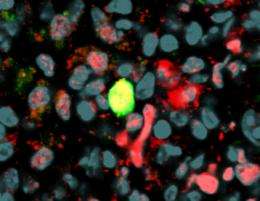Discovery of a mechanism controlling the fate of hematopoietic stem cells

(PhysOrg.com) -- Hematopoietic stem cells are capable of manufacturing all types of blood cells. But which factors influence the production of a specific type of cell? Until now, it was thought that this was a random process.
At the Centre d'Immunologie de Marseille-Luminy, a team of CNRS and Inserm (France) researchers led by Michael Sieweke has discovered the factors that determine the type of cells produced. The mechanism they have demonstrated in the mouse involves one factor intrinsic to the cell and one extrinsic factor. These results were published in the journal Cell on July 24, 2009.
Stem cells are a source of much hope, thanks to their extraordinary ability to produce all types of cell in the body or an organ, depending on their origin. Scientists are now trying to understand the mechanisms that commit stem cells to a particular specialization.
At the Centre d'Immunologie de Marseille-Luminy, CNRS and INSERM researchers have been working on mouse hematopoietic stem cells. They studied the development of myeloid cells, a lineage of white blood cells that combats microorganisms by "eating" them, by releasing toxins or by alerting other specialized immune cells. Until now, it was thought that the production of different specialized cells from a hematopoietic stem cell was a random process. Sieweke's team has discovered that in the case of myeloid cells, it is the combined action of two proteins which is relevant; one protein that is situated inside the cell (transcription factor) and the other outside (a cytokine).
Transcription factors are capable of switching genes on or off. The identity of a cell is the combination of active genes it possesses. Because of this, scientists already suspected that transcription factors played an important role in the orientation of differentiation. They also knew that blood cells can only prosper in an environment containing a particular cytokine, a type of hormone specific to each cell type. But until now, they thought that cytokines assisted the survival and renewal of cells without affecting their "fate". The team in Marseille has now shown that a specific cytokine (M-CSF) places stem cells on a "myeloid pathway", but that these stem cells can only follow this path if levels of a certain transcription factor (MafB) within the cells is low. These findings help to solve a mystery that has fascinated specialists during the past fifty years. In the longer term, these results may throw new light on the mechanisms of leukemia, where abnormal stem cells remain "undecided" and are still able to escape therapy.
Until now, studies on hematopoietic stem cells had opened the way to research on stem cells in other tissues. In this context, the results achieved and published by Michael Sieweke and his colleagues may provide more general information on how stem cells function (in the brain, muscle or intestine).
More information: MAFB Restricts M-CSF Dependent Myeloid Commitment Divisions of Hematopoietic Stem Cells,
Sandrine Sarrazin, Noushine Mossadegh-Keller, Taro Fukao, Athar Aziz, Frederic Mourcin, Laurent Vanhille, Louise M. Kelly-Modis, Philippe Kastner, Susan Chan, Estelle Duprez, Claas Otto and Michael H. Sieweke, Cell, 24 July 2009 .
Provided by CNRS













